Wolfram Function Repository
Instant-use add-on functions for the Wolfram Language
Function Repository Resource:
Generate a random chord of a circle
ResourceFunction["RandomCircleChord"][type] returns a random chord of type type. | |
ResourceFunction["RandomCircleChord"][type,n] returns n random chords of type type. | |
ResourceFunction["RandomCircleChord"][type,n,format] returns n random chords of type type with the output format format. |
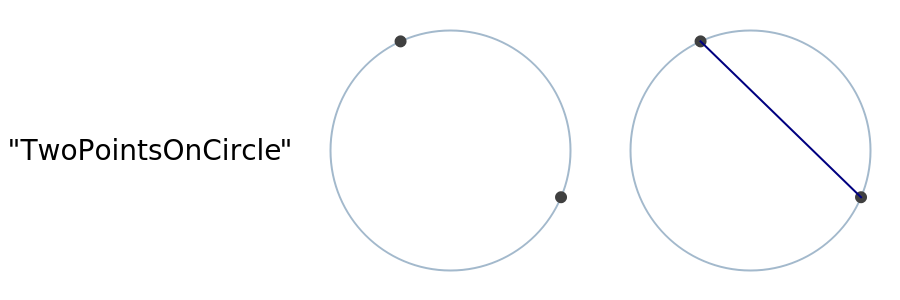
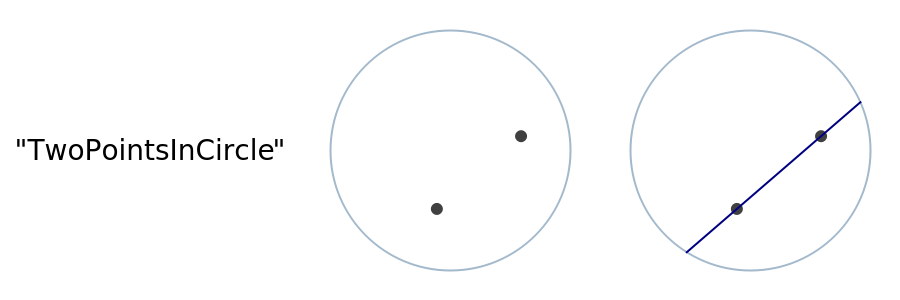
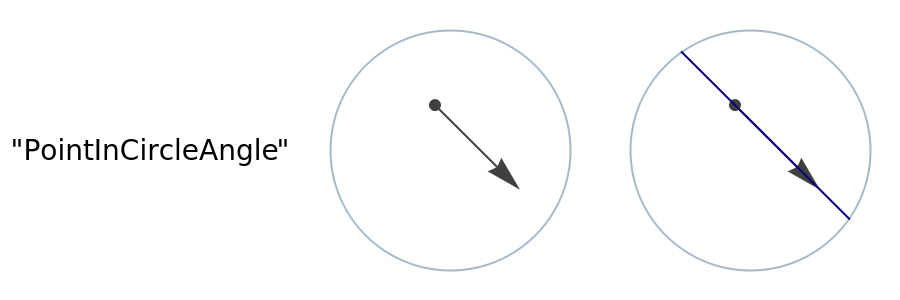

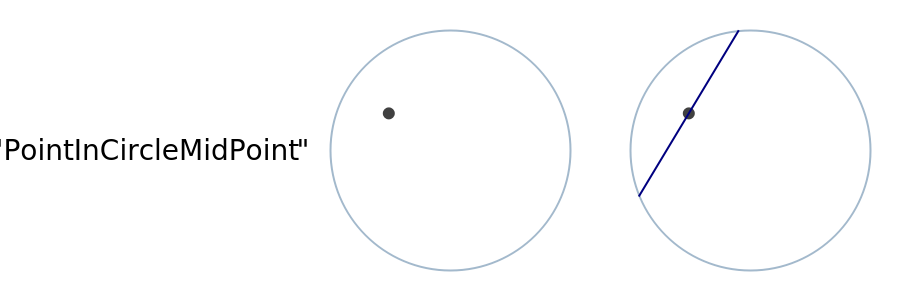
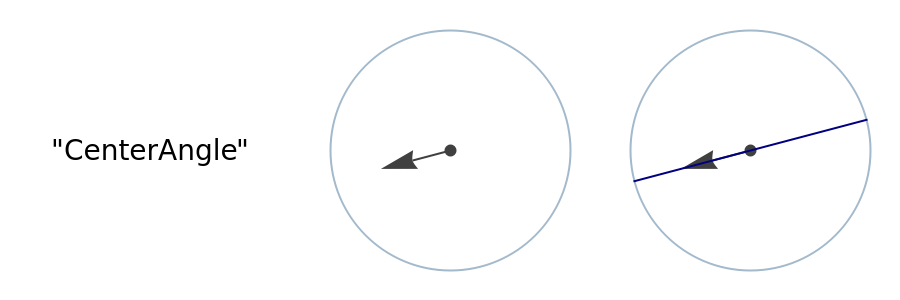
Generate a random circle chord:
| In[1]:= |
| Out[1]= |
Generate 100 random circle chords and visualize:
| In[2]:= |
| Out[2]= |  |
Retrieve all types:
| In[3]:= |
| Out[3]= |
By default, the chords are returns as a list of Line objects::
| In[4]:= |
| Out[4]= |
Get the endpoints of the chord:
| In[5]:= |
| Out[5]= |
Represent the chords as a single Line object:
| In[6]:= |
| Out[6]= |
Get the midpoints of each chord:
| In[7]:= |
| Out[7]= |
Generate 50 chords and return a single Line object:
| In[8]:= |
| Out[8]= |  |
Find the chance of each slice of a pie getting a candle given that the two candles are randomly placed and the cake randomly cut:
| In[9]:= | ![n = 50000;
Table[
{t, Count[Table[
pts = RandomPoint[Disk[], 2];
{{ch1x, ch1y}, {ch2x, ch2y}} = ResourceFunction["RandomCircleChord"][t, 1, "EndPoints"][[1]];
Graphics[{Point[pts], Line[{{ch1x, ch1y}, {ch2x, ch2y}}], Circle[]}];
booles = (ch2x - ch1x) (#[[2]] - ch1y) - (ch2y - ch1y) (#[[1]] -
ch1x) > 0 & /@ pts;
booles[[1]] === ! booles[[2]]
,
{n}
], True]/N[n]}
,
{t, ResourceFunction["RandomCircleChord"][All]}
] // Grid](https://www.wolframcloud.com/obj/resourcesystem/images/9c0/9c06b5ac-46b4-42cb-a990-6e7e7543f951/5a2a101a99d37429.png) |
| Out[10]= |  |
Compare the distribution of midpoints visually:
| In[11]:= | ![types = ResourceFunction["RandomCircleChord"][All];
midpts = Table[ResourceFunction["RandomCircleChord"][t, 1000, "Midpoints"], {t, types}];
{types, Graphics[{Point[#], Circle[]}, ImageSize -> 150] & /@ midpts} // Transpose // Grid](https://www.wolframcloud.com/obj/resourcesystem/images/9c0/9c06b5ac-46b4-42cb-a990-6e7e7543f951/526190773749e8bf.png) |
| Out[13]= |  |
Find the radial distribution of the midpoints:
| In[14]:= | ![types = ResourceFunction["RandomCircleChord"][All];
rs = Table[
Norm /@ ResourceFunction["RandomCircleChord"][t, 100000, "Midpoints"], {t, types}];
{types, Histogram[#, {0, 1, 0.02}, "PDF", ImageSize -> 200, Frame -> True, ImagePadding -> {{20, 10}, {20, 10}}] & /@ rs} //
Transpose // Grid](https://www.wolframcloud.com/obj/resourcesystem/images/9c0/9c06b5ac-46b4-42cb-a990-6e7e7543f951/482ef492ceb537c1.png) |
| Out[15]= | 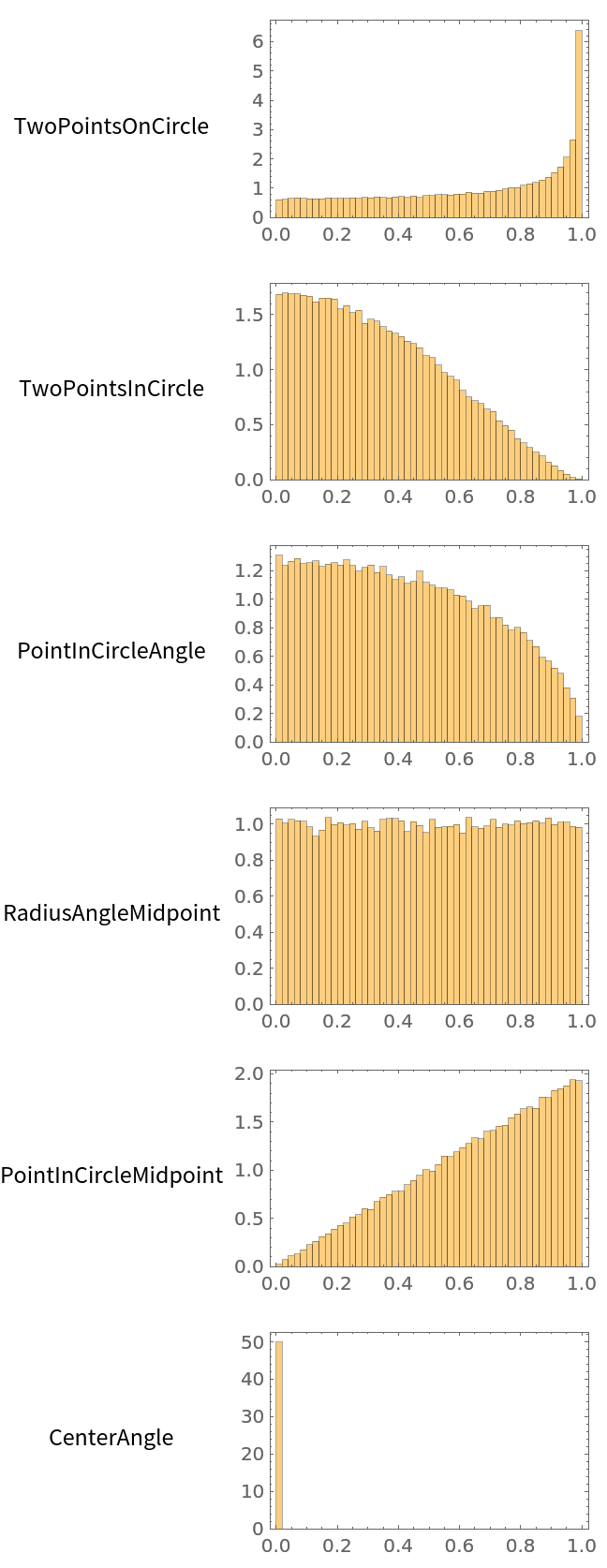 |
Check the Bertrand paradox for a variety of ways of generating random chords:
| In[16]:= | ![baselen = Norm[First[Differences[CirclePoints[3]]]];
n = 10^5;
Table[
out = ResourceFunction["RandomCircleChord"][t, n, "EndPoints"];
out = Norm[#2 - #1] & @@@ out;
out -= baselen;
{t, Total[UnitStep[out]]/N[n]}
,
{t, ResourceFunction["RandomCircleChord"][All]}
] // SortBy[Last] // Grid](https://www.wolframcloud.com/obj/resourcesystem/images/9c0/9c06b5ac-46b4-42cb-a990-6e7e7543f951/2e95d8b3e76c62d3.png) |
| Out[18]= |  |
This work is licensed under a Creative Commons Attribution 4.0 International License